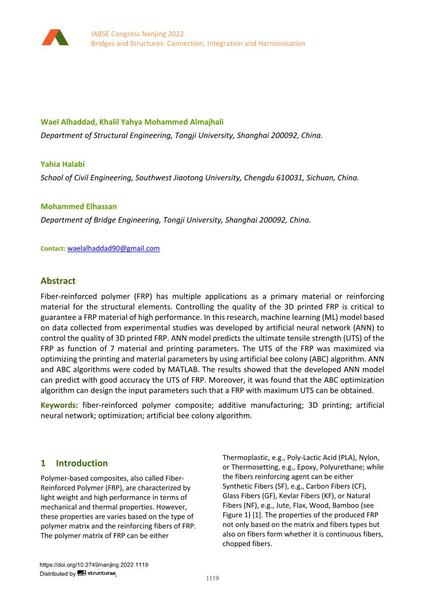Modeling and Optimization for The Tensile Properties of 3D-Printed FRP using Artificial Neural Network and Artificial Bee Colony Algorithm

|
|
|||||||||||
Bibliographic Details
| Author(s): |
Wael Alhaddad
(Department of Structural Engineering, Tongji University, Shanghai 200092, China.)
Khalil Yahya Mohammed Almajhali (Department of Structural Engineering, Tongji University, Shanghai 200092, China.) Yahia Halabi (School of Civil Engineering, Southwest Jiaotong University, Chengdu 610031, Sichuan, China.) Mohammed Elhassan (Department of Bridge Engineering, Tongji University, Shanghai 200092, China.) |
||||
|---|---|---|---|---|---|
| Medium: | conference paper | ||||
| Language(s): | English | ||||
| Conference: | IABSE Congress: Bridges and Structures: Connection, Integration and Harmonisation, Nanjing, People's Republic of China, 21-23 September 2022 | ||||
| Published in: | IABSE Congress Nanjing 2022 | ||||
|
|||||
| Page(s): | 1119-1128 | ||||
| Total no. of pages: | 10 | ||||
| DOI: | 10.2749/nanjing.2022.1119 | ||||
| Abstract: |
Fiber-reinforced polymer (FRP) has multiple applications as a primary material or reinforcing material for the structural elements. Controlling the quality of the 3D printed FRP is critical to guarantee a FRP material of high performance. In this research, machine learning (ML) model based on data collected from experimental studies was developed by artificial neural network (ANN) to control the quality of 3D printed FRP. ANN model predicts the ultimate tensile strength (UTS) of the FRP as function of 7 material and printing parameters. The UTS of the FRP was maximized via optimizing the printing and material parameters by using artificial bee colony (ABC) algorithm. ANN and ABC algorithms were coded by MATLAB. The results showed that the developed ANN model can predict with good accuracy the UTS of FRP. Moreover, it was found that the ABC optimization algorithm can design the input parameters such that a FRP with maximum UTS can be obtained. |
||||
| Keywords: |
optimization additive manufacturing 3D printing Artificial Neural Network fiber-reinforced polymer composite artificial bee colony algorithm
|
||||
| Copyright: | © 2022 International Association for Bridge and Structural Engineering (IABSE) | ||||
| License: | This creative work is copyrighted material and may not be used without explicit approval by the author and/or copyright owner. |
||||
